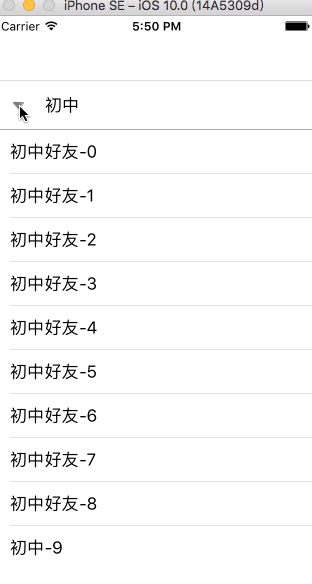下面我们通过实例代码来一步步看怎么实现, 首先建立了两个模型类, 一个Friend, 一个FriendGroup类. 数据源用的本地的一个plist文件. plist文件中包含了FriendGroup的name,friends数组等属性.
Friend.h 示例代码
#import <Foundation/Foundation.h> @interface Friend : NSObject @property (nonatomic, copy) NSString *name; @end
FriendGroup.h 示例代码
#import <Foundation/Foundation.h> @interface FriendGroup : NSObject @property (nonatomic, copy) NSString *name; // 数组中存放的为Friend类的实例对象 @property (nonatomic, copy) NSMutableArray *friends; // 用来判断分组是否打开(opened属性正是实现下拉列表的关键) @property (nonatomic, assign, getter = isOpened) BOOL opened; // 自定义方法用来赋值 -(void)setFriendGroupDic:(NSMutableDictionary *)dic; @end
FriendGroup.m 示例代码
#import "FriendGroup.h" #import "Friend.h" @implementation FriendGroup -(void)setFriendGroupDic:(NSMutableDictionary *)dic { // 通过字典给FriendGroup的属性赋值 [self setValuesForKeysWithDictionary:dic]; NSMutableArray *tempArray = [NSMutableArray array]; // 遍历friends属性数组 for (NSMutableDictionary *dic in self.friends) { Friend *friend = [[Friend alloc] init]; [friend setValuesForKeysWithDictionary:dic]; [tempArray addObject:friend]; } //重新对friends属性数组赋值,此时存的都是Friend对象 self.friends = [NSMutableArray arrayWithArray:tempArray]; } @end
在ViewController中创建一个tableView
#import "ViewController.h" #import "SectionView.h" #import "FriendGroup.h" #import "Friend.h" #define kTableViewReuse @"reuse" @interface ViewController ()<UITableViewDelegate, UITableViewDataSource, SectionViewDelegate> @property (nonatomic, strong) UITableView *tableView; // 数组中存放FriendGroup的实例对象 @property (nonatomic, strong) NSMutableArray *allArray; @end @implementation ViewController - (void)viewDidLoad { [super viewDidLoad]; self.allArray =[NSMutableArray array]; [self creatTableView]; [self getData]; } - (void)creatTableView { self.tableView = [[UITableView alloc] initWithFrame:self.view.bounds style:UITableViewStylePlain]; _tableView.delegate = self; _tableView.dataSource = self; [_tableView registerClass:[UITableViewCell class] forCellReuseIdentifier:kTableViewReuse]; [self.view addSubview:_tableView]; } // 获取数据 - (void)getData { NSString *filePath = [[NSBundle mainBundle] pathForResource:@"friends.plist" ofType:nil]; NSArray *tempArray = [NSArray arrayWithContentsOfFile:filePath]; for (NSMutableDictionary *dic in tempArray) { FriendGroup *friendGroup = [[FriendGroup alloc] init]; [friendGroup setFriendGroupDic:dic]; [self.allArray addObject:friendGroup]; } [self.tableView reloadData]; } - (CGFloat)tableView:(UITableView *)tableView heightForHeaderInSection:(NSInteger)section { return 50; } // SectionView必须实现的协议方法 - (void)touchAction:(SectionView *)sectionView { } #pragma mark - TableView Delegate -(UIView *)tableView:(UITableView *)tableView viewForHeaderInSection:(NSInteger)section { FriendGroup *friendGroup = [self.allArray objectAtIndex:section]; //放一个封装的view,view上有一个label和imageVIew,自带touch事件,点击触发协议方法 SectionView *sectionView = [[SectionView alloc] initWithFrame:CGRectMake(0, 0, 375, 50)]; sectionView.delegate = self; sectionView.tag = section + 1000; sectionView.textLabel.text = friendGroup.name; sectionView.group = friendGroup; return sectionView; } #pragma mark - TableView DataSource - (NSInteger)numberOfSectionsInTableView:(UITableView *)tableView { return _allArray.count; } - (NSInteger)tableView:(UITableView *)tableView numberOfRowsInSection:(NSInteger)section { return [_allArray[section] friends].count; } - (UITableViewCell *)tableView:(UITableView *)tableView cellForRowAtIndexPath:(NSIndexPath *)indexPath { UITableViewCell *cell = [tableView dequeueReusableCellWithIdentifier:kTableViewReuse]; FriendGroup *friendGroup = _allArray[indexPath.section]; Friend *friend = friendGroup.friends[indexPath.row]; cell.textLabel.text = friend.name; return cell; } #pragma mark - Memory Waring - (void)didReceiveMemoryWarning { [super didReceiveMemoryWarning]; // Dispose of any resources that can be recreated. } @end
可以从上面代码看到, 创建了一个tableView. 并根据数组个数给分区数量赋值, 然后在tableView: viewForHeaderInSection:方法里, 用一个自定的view给分区头视图赋值. 在tableView: cellForRowAtIndexPath:方法里给每个分区对应的cell进行了赋值. 先看一下效果.

从上图可以看到现在每个分区中对应有不同数量的row,但是还没有实现我们想要的效果.所以再往下继续看.
SectionView.m
-(void)touchesBegan:(NSSet *)touches withEvent:(UIEvent *)event { [self.delegate touchAction:self]; } /* [self.delegate touchAction:self]; 协议方法会刷新tableview,然后会刷新tableview的 viewForHeaderInSection:方法 就会重新布局SectionView所以会走layoutSubviews方法 */ -(void)layoutSubviews { [super layoutSubviews]; // 改变imageView的transform属性 点击时有开闭的效果 [UIView animateWithDuration:0.3 animations:^{ _imageView.transform = _group.opened ? CGAffineTransformMakeRotation(M_PI_2) : CGAffineTransformMakeRotation(0); }]; }
点击SectionView时 就让代理人去执行协议方法,但是在VC的协议方法中什么都没写, 所以需要完善一下
- (void)touchAction:(SectionView *)sectionView { // 通过前面设置的tag值找到分区的index NSInteger index = sectionView.tag - 1000; FriendGroup *group = [self.allArray objectAtIndex:index]; // 每次点击, 状态变为与原来相反的值 group.opened = !group.isOpened; [self.tableView reloadSections:[NSIndexSet indexSetWithIndex:index] withRowAnimation:UITableViewRowAnimationNone]; }
我们平时用的QQ下拉列表, 未打开时不显示好友, 打开后才展示好友列表. 所以应该在numberOfRowsInSection方法中要进行设置.
- (NSInteger)tableView:(UITableView *)tableView numberOfRowsInSection:(NSInteger)section { FriendGroup *group = [self.allArray objectAtIndex:section]; // 如果未打开 count为0 如果打开 count为group的属性数组对应的个数 NSInteger count = group.isOpened ? group.friends.count : 0; return count; }
效果如下图

总结
以上就是IOS实现简易版的QQ下拉列表的全部内容,效果虽然很简单,但还会希望对大家开发IOS有所帮助。
【IOS实现简易版的QQ下拉列表】相关文章:
